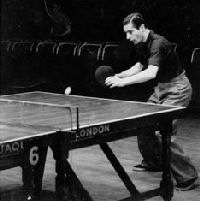You Are Here: Home » History of Table Tennis » What happened in the 1930s?
Table Tennis History
What happened in the 1930s?
What controversies will linger in the annals of table tennis history?
Why did the 1930s leave such a lasting legacy? Find out here...
By Martin Hughes
Owner and Editor

Table tennis started in the late 1800s and for any sport which lasts for more than a century there'll inevitably be change and controversy throughout its' history.
And table tennis is no different.
Indeed, all table tennis history aficionados will know about the major controversies which occurred in the 1930s.
By the way, if you're interested in a brief history of the origin of table tennis, you'll find it here.
So how much do you know about any of the major controversies which took place in years gone by? Controversies which left a lasting legacy on the way we play the game today.
Not a lot?
TABLE TENNIS EXPERT
REVEALS HIS SECRETS
Click Here For Details

Click here for a large selection of
table tennis equipment at Megaspin *

Click here for a large selection of
table tennis equipment at Bribar *
^ Top of page ^
Well, let's take a look at the 1930s...
In the beginning
Although our table tennis history can be traced back to the late 1800s, the game we know today started in the 1920s when Englishman Ivor Montagu, together with some other Europeans, formed the International Table Tennis Federation (ITTF) in 1926.
But it didn't take long before problems started to emerge.
TABLE TENNIS EXPERT
REVEALS HIS SECRETS
Click Here For Details

Click here for a large selection of
table tennis equipment at Megaspin *

Click here for a large selection of
table tennis equipment at Bribar *
^ Top of page ^
The rules of table tennis were already being amended and refined when the 1930s saw...
The first major controversy
The table tennis history books will no doubt recall that the first major controversy of the modern era occurred in the mid 1930s.
Because the rackets of the day meant that players were unable to generate as much speed and spin as they can today, many players used a defensive style of play.
Their main tactic was just to try and keep the ball in play. And they did this by using only one stroke ... the push.
This became known as "chiseling" and because both players often used the same tactic, it caused many games to last a considerable length of time.
Indeed at the 1936 World Championships in Prague, Czechoslovakia, the first point in a match between Poland and Romania lasted for over two hours! And the Swaythling Cup (Men's Team) finals took eleven hours to complete.
^ Top of page ^
But, not only did the length of some matches cause concern. The 1936 World Championship event also saw the introduction of...
Finger spin serves
By imparting spin onto the ball with their fingers, or by rubbing the ball against the racket before it left their hand, players were able to generate spin serves which gave them a considerable advantage over their opponent.
^ Top of page ^
This prompted the ITTF to make more...
Rule changes
Finger spin serves caused such a controversy at the time that, from the start of the 1937/38 season, three major changes were made to the rules of table tennis...
- A time limit was placed on games
- The height of the net was lowered, and
- Finger spin serves were banned
1. Time limit on games
Because games were becoming longer and longer, a time limit of 20 minutes was placed on games in World Championship events ... and all countries affiliated to the ITTF were asked to pursue their own measures to discourage "pushing" within their own country.
And that's how our table tennis history has given us the rule known today as the expedite rule.
NB. Since the change to the 11up scoring system in 2001, the time limit is now 10 minutes per game.
Secondly, they agreed to...
2. Lower the height of the net
To encourage players to adopt a more offensive, attacking style of play, it was also decided that the height of the net would be lowered from 6.75 inches to 6 inches.
This, in conjunction with a time limit of 20 minutes, would assist any player who was trying to play offensively and would generally promote a more attacking style of play.
The height of the net has remained at 6 inches ever since.
However, it's interesting to note that, due to the speed of the modern game, there are many people who now believe that the height of the net should be increased ... in order to slow the game down and assist players who use a defensive style of play!
Thirdly, they also agreed to...
3. Ban finger spin serves
Finger spin serves had become so popular during the 1930s that the ITTF decided that, in the best interests of the game, they should change the service rule and make them illegal.
The service rule at the time stated...
The service shall be delivered by the server projecting or dropping the ball by hand only, without deliberate deformation of the surface, into the air.
And the new wording was...
The service shall be delivered by the server releasing the ball by hand only, without imparting of spin, into the air.
Additionally, umpires were instructed that any form of spin imparted by anything other than the racket, was prohibited ... AND that if they were in any doubt about the serve, that they must order any player to use an open and flat serving hand, with the fingers straight and together, and the thumb free.
If the player failed to comply, he would lose the point.
And that is how the current service rule which states...
Service shall start with the ball resting freely on the open palm of the server's stationary free hand.
... came into existence.
^ Top of page ^
| MORE PAGES ABOUT THE HISTORY OF TABLE TENNIS |
|---|
For more information about the history of table tennis, take a look at my other articles...
General history of table tennis
Significant events in the history of table tennis
And... |
Click here for a large selection of
table tennis equipment at Megaspin *

Click here for a large selection of
table tennis equipment at Bribar *
^ Top of page ^
You Are Here: Home » History of Table Tennis » What happened in the 1930s?
